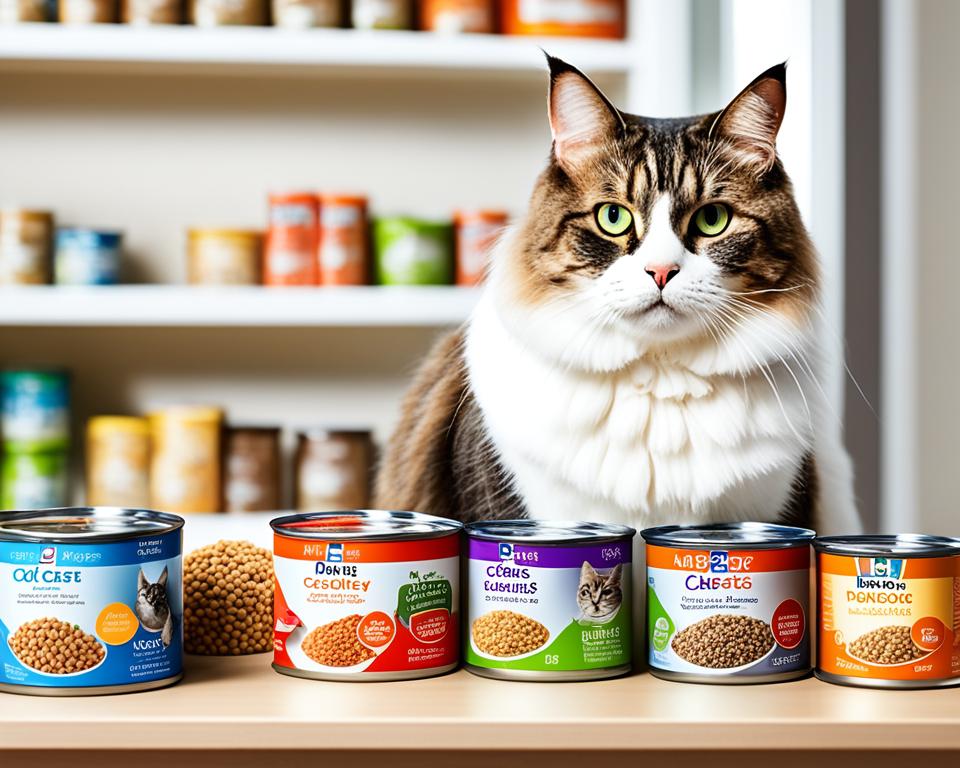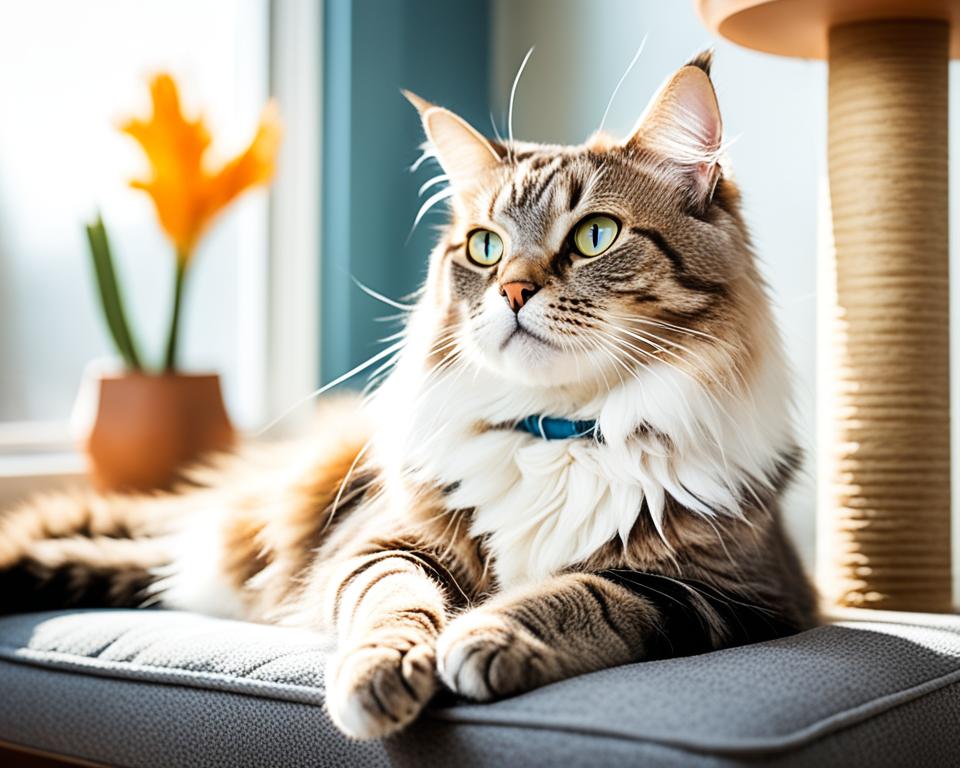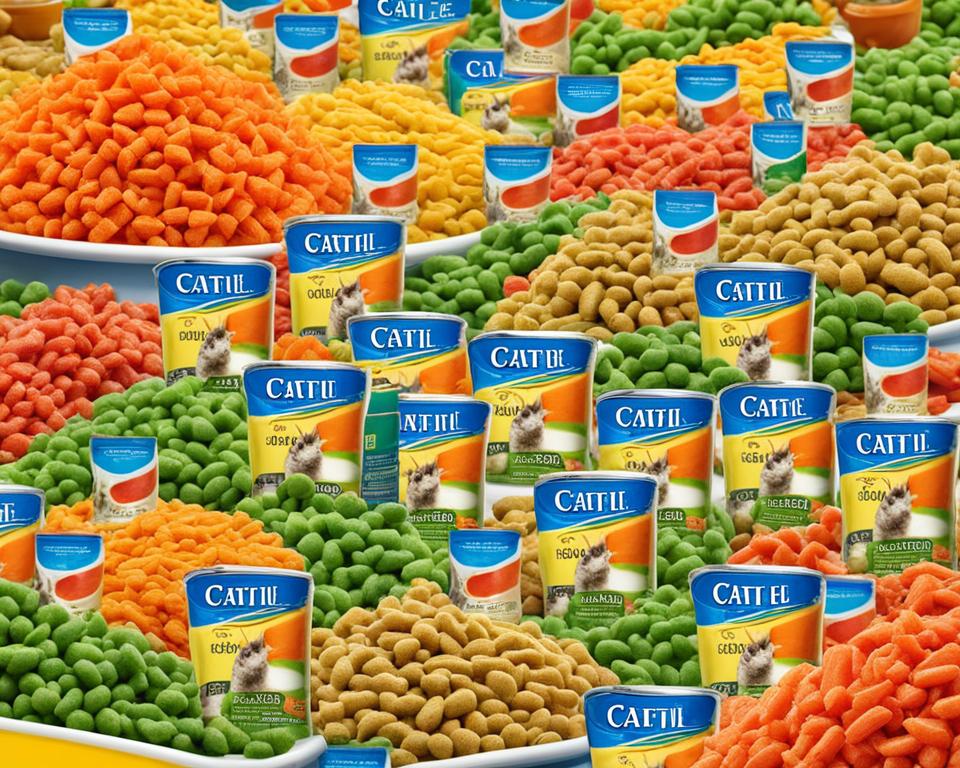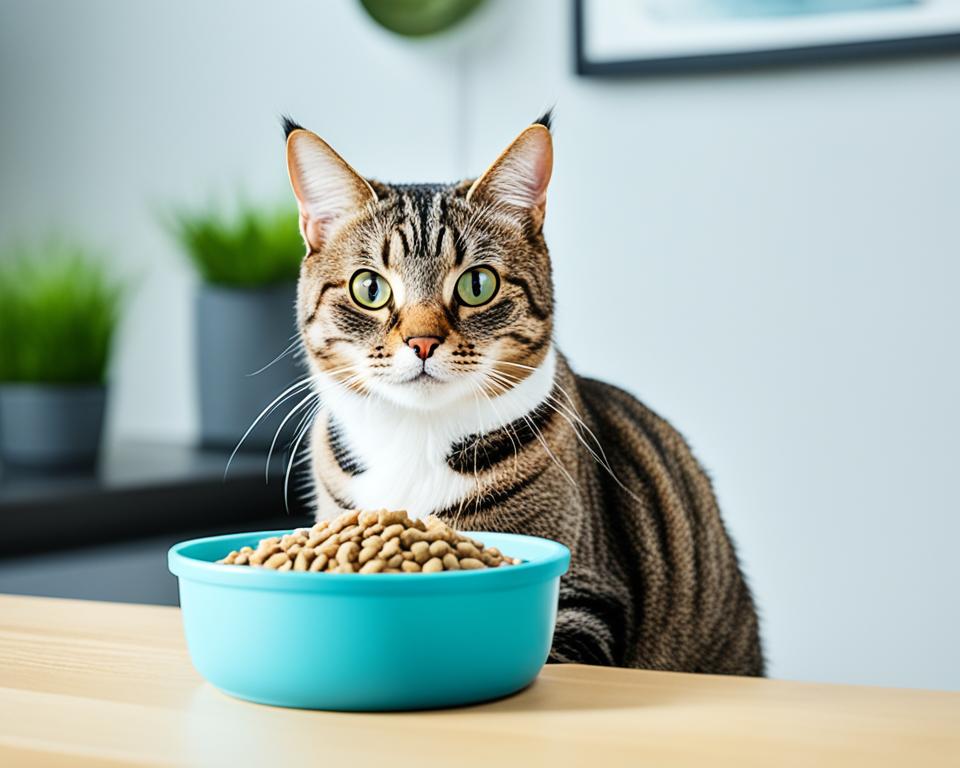I’m excited to share my findings on the best cat food for indoor cats in 2023. As a cat owner, I know how important it is to give our feline friends the right food. Indoor cats need different nutrition than outdoor cats. It’s key to pick food that fits their needs.
Natural cat food options are getting popular. Brands like Royal Canin and Hill’s Science Diet are at the top. These foods help with weight management, hairball control, and keeping the digestive system healthy. The best foods have more fiber, fewer calories, and important nutrients for cats.
In my research, I found top brands like Purina One meet AAFCO standards. These standards make sure cat food has the six key nutrients cats need. These are water, protein, carbs, vitamins, minerals, and fats. It’s good to know we can find quality food that fits our indoor cats’ health needs.
Understanding Indoor Cat Nutrition
Feeding your indoor cat the right food is key to their health and happiness. Indoor cats need different food than outdoor cats. Let’s explore what your kitty needs to eat.
Essential Nutrients for Indoor Cats
Indoor cats need a diet full of high-quality proteins. They are meat-eaters and do best with proteins like chicken, turkey, fish, or beef. This keeps them strong and healthy.
Here’s what indoor cats need:
- Protein: 30-40% of daily calories
- Fat: 15-20% of daily calories
- Carbohydrates: 1-2% of daily calories
- Water: 60 ml per kg of body weight daily
Differences Between Indoor and Outdoor Cat Diets
Indoor cats eat differently than outdoor cats. They need fewer calories because they move less. Indoor cats should eat about 40 calories per kg of body weight, not 70-80 like outdoor cats.
A study showed 44% of indoor cats in the UK were too heavy. This shows why it’s important to watch what they eat to avoid obesity.
The Role of AAFCO Standards in Cat Food
The Association of American Feed Control Officials (AAFCO) sets food standards for pets. When picking cat food, I check for the AAFCO label. This makes sure the food has the right nutrients for cats.
| Food Type | Benefits | Considerations |
|---|---|---|
| Wet Food | High moisture content, higher protein | Supports hydration, good for urinary health |
| Dry Food | Convenient, supports dental health | Should have high protein, low carbs (0-10%) |
| Grain-Free | May benefit cats with sensitivities | Not necessary for all cats |
Choosing grain-free or high-protein cat food is up to you. The main thing is to feed your indoor cat a balanced diet that fits their needs. Good food is the key to a happy, healthy indoor cat!
Best Cat Food for Indoor Cats: Top Picks for 2023

I’ve looked into many cat food brands to find the best for our feline friends. In 2023, indoor cats need special nutrition. Let’s look at some great choices for these needs.
Dry Food Options for Indoor Cats
Dry cat food is good for dental health and easy for owners. Royal Canin Indoor Adult is a top choice with kibble that slows down tartar. Farmina Natural and Delicious Adult Chicken and Pomegranate has 44% protein. It’s great for less active indoor cats.
Wet Food Choices for Indoor Felines
Wet cat food helps with weight and staying hydrated. Purina One +Plus Indoor Advantage is a great pick, with L-carnitine for weight control. Royal Canin Indoor Adult Cats Morsels in Gravy has a balanced mix of 52.47% protein, 20.24% fat, and 3.28% fiber. These foods also help with hairballs.
Budget-Friendly Indoor Cat Food Solutions
Good nutrition doesn’t have to be expensive. Natural Balance and Iams offer affordable wet food that keeps your cat healthy. Blue Buffalo’s indoor cat formula is a dry option in a five-pound bag, helping with weight control. These choices let your indoor cat eat well without spending a lot.
| Brand | Type | Key Benefit |
|---|---|---|
| Royal Canin Indoor Adult | Dry | Tartar Control |
| Purina One +Plus Indoor Advantage | Wet | Weight Management |
| Blue Buffalo Indoor Formula | Dry | Budget-Friendly |
The best cat food for your indoor cat depends on their needs. Always talk to your vet before changing your cat’s diet.
Tailored Nutrition for Different Life Stages

Cats’ nutritional needs change as they get older. Kittens need food full of vitamins for muscle and brain growth. Adult cats need food to keep a healthy weight and stay healthy.
Senior indoor cat food is key for older cats. It has extra vitamins and minerals for their aging bodies. Some formulas even have glucosamine for joint health.
Cat food for urinary health is also vital. Indoor cats often have urinary tract problems because they drink less water. Wet food can help keep them hydrated, lowering the risk of blockages and constipation.
| Life Stage | Key Nutritional Needs | Recommended Food Type |
|---|---|---|
| Kitten | High protein, DHA for brain development | Kitten-specific formulas |
| Adult | Balanced nutrition, weight management | Adult maintenance formulas |
| Senior | Joint support, digestive health | Senior-specific formulas |
| All Ages | Urinary health support | Wet food or urinary health formulas |
Every cat is different. Always talk to a vet to find the best food for your cat’s needs and age.
Addressing Common Health Concerns Through Diet

Indoor cats have special health issues. The right diet can help with weight, hairballs, and digestion. Let’s look at how to tackle these problems with food.
Weight Management for Indoor Cats
Indoor cats often get too heavy because they don’t move much. Eating low-calorie cat food helps with weight control. These foods give the cat what it needs but with fewer calories. Foods high in protein also help keep muscles strong while losing weight.
Don’t give your cat too many treats, just 10-15% of their daily calories. It’s important to control how much they eat. Always talk to a vet for advice on how much to feed your cat, based on its age, weight, and how active it is.
Hairball Control Through Nutrition
Hairballs are a big problem for indoor cats. Special cat food can make them less common. These foods have more fiber to help move hair through the cat’s body.
Look for foods with natural fiber like beet pulp or cellulose. Some formulas also have omega-3 fatty acids. These help with healthy skin and coat, which can mean less shedding.
Supporting Digestive Health with Fiber
Fiber is very important for a cat’s digestive health. It keeps bowel movements regular and supports good gut bacteria. Foods with prebiotics and probiotics can make digestion even better.
| Health Concern | Dietary Solution | Key Ingredients |
|---|---|---|
| Weight Management | Low-calorie, high-protein cat food | Lean proteins, L-carnitine |
| Hairball Control | Hairball control cat food | Natural fibers, omega-3 fatty acids |
| Digestive Health | Fiber-rich cat food | Prebiotics, probiotics, soluble fiber |
Every cat is different. Always talk to your vet before changing your cat’s diet. They can give advice that fits your cat’s health needs and issues.
Key Ingredients to Look for in Indoor Cat Food
Choosing the right food for indoor cats is key for their health. I always look for natural cat food with high-quality protein as the first ingredient. Cats need a lot of protein, about 26% to 30% for growth and reproduction.
High-protein cat food is a must for indoor cats. I want to see named protein sources like chicken, turkey, or salmon at the top of the list. Fat content should be around 9% of dry matter. Foods with omega-3 and omega-6 fatty acids are good for their skin and coat.
For good digestion, I pick foods with 3-5% fiber. Ingredients like beet pulp and psyllium husk help with digestion and reduce hairballs. Some grain-free options also have L-carnitine for weight control, which is great for less active indoor cats.
| Nutrient | Recommended Level | Benefits |
|---|---|---|
| Protein | 26-30% | Muscle maintenance, growth |
| Fat | 9% | Energy, coat health |
| Fiber | 3-5% | Digestive health, hairball control |
| Taurine | Essential | Heart and eye health |
I steer clear of artificial preservatives, colors, and flavors in cat food. Instead, I choose foods with natural preservatives like Vitamin C and E. Taurine is also a must, as it’s vital for heart and eye health in cats.
Feeding Guidelines and Transitioning to New Food
Feeding your indoor cat right is key. I suggest giving them two to three meals a day at the same time. Make sure to take away any food left over after 20-30 minutes. This keeps the food fresh and helps prevent overeating.
Switching from wet to dry cat food? Do it slowly. Try mixing the new food with their old food for 7-10 days. Start with 25% new and 75% old, then move to 50% new and 50% old. By day 7, you can switch fully to the new food.
Watch your cat closely when changing their diet. If they start vomiting or have diarrhea, slow down the change. Adding a bit of wet food can help picky eaters. Always put your cat’s health first – see a vet if they stop eating or lose weight. With care, you’ll find the right food for your indoor cat.

